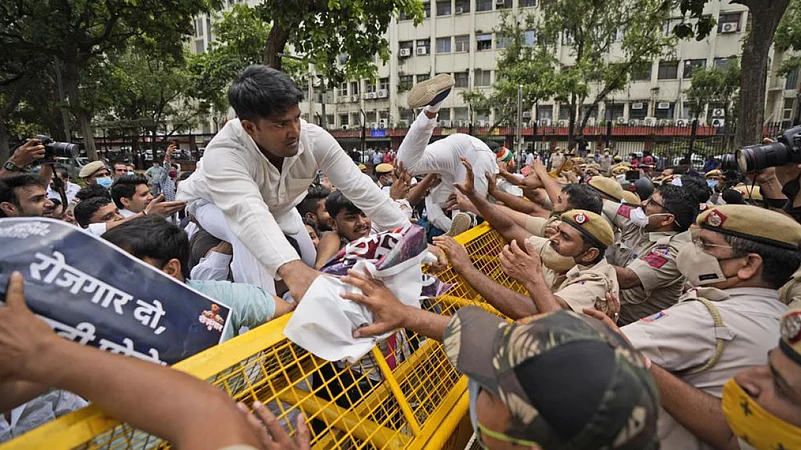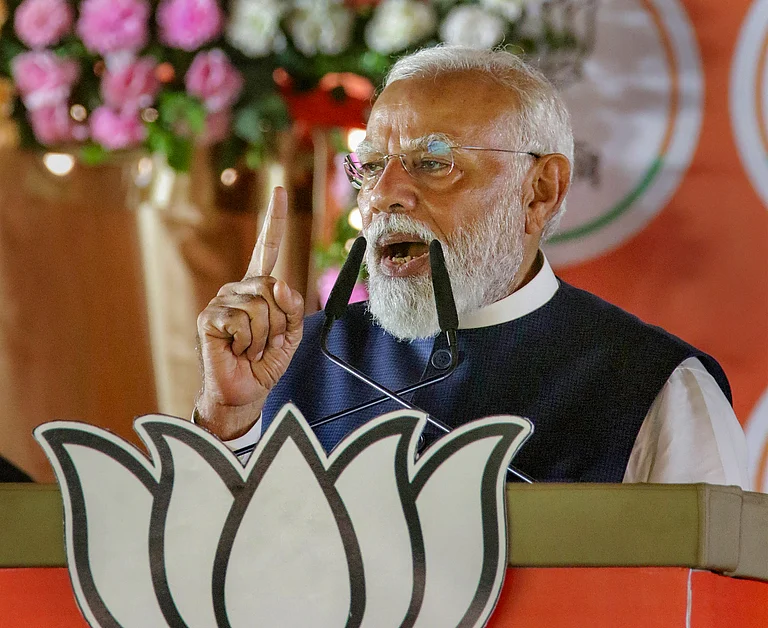In a 2013 election campaign rally, then Gujarat Chief Minister and BJP’s Prime Ministerial candidate Narendra Modi had said that with 65 per cent of the Indian population below the age of 35, the youth, currently struggling with unemployment, can be galvanised into a force for the development of the country. The party eventually came to power after promising to create one crore (10 million) jobs each year.
Cut to 2022 and despite nearly a decade of the Modi government in power, employment rates are dismal. Just a few days ago, thousands of unemployed youth of the nation - once pitched as an asset - were shamed and lathi-charged when they took to streets in Bihar and Uttar Pradesh - two of India’s most populated states - and damaged national property including railway tracks. The job seekers were protesting against the alleged discrepancies in the recruitments for railways which they claimed were partial to graduates applying to low-skill jobs.

The crisis brought to the fore a familiar problem that often gets limelight ahead of elections but eventually simmers down to just schemes and statistics until the next polls - the crisis of unemployment. While the burning cars and flaming tires on railway tracks made for concerning visuals, the fact is that protests over unemployment and job loss are perennial in India. And so are the promises made by politicians. With each election year, politicians and parties draw up manifestos in which they promise an incredible number of jobs. But while the unavailability of jobs seems to impact elections less and less these days, the impact of elections on jobs is even more scarce.
Job plank
In Bihar, for instance, the 2020 election saw a huge push for employment and job creation. Many editorials were written about elections finally becoming a poll issue. Ahead of the highly contested election, Tejashwi Yadav promised 1 million jobs if voted to power. To counter that, the BJP promised 1.9 million jobs. This was interesting because the BJP has in the past few years refocused its poll pitches away from issues like education and employment to more “emotional” keywords like nationalism and political as well as religious identity politics.

The National Democratic Alliance emerged victorious in the elections. Did the promise for more jobs have any bearing on the results? It may or may not have but the elections definitely failed to impact the unemployment crisis in Bihar. According to CMIE data, the current rate of unemployment in Bihar is 13.5 per cent. A massive 12.5 million aspirants applied to 35,000 job openings in the railways, reflecting the crisis of job seekers, including skilled and educated youth. The unemployment rate also does not reflect the number of educated or over skilled persons working in unskilled jobs.
The situation is not any better across the country. With over 52 million job seekers in December 2021, the unemployment rate fell to 6.57 in January for the first time since March 2021. CMIE’s real-time tracker shows that the unemployment rate in February 2020 is hovering over 7 per cent. The figures still remain much higher than the global average. The data does not reflect the true number of unemployed persons, however, as it does not record those who were not looking for a job despite unemployment at the time.

The discrepancies in the way unemployment data is collected in India often plays to the advantage of politicians. In 2020, for instance, Nitish Kumar claimed that his government had created 6 lakh jobs in 15 years in Bihar. As per the Niti Aayog's Multi-dimensional Poverty Index (MPI), Bihar has the highest proportion of "multidimensionally poor" people. 51.91 per cent of the state's population falls under this section. At a media conclave held by Network18 group in 2019, PM Modi had said that 12 million jobs had been created each year in the past four years in the formal sector. The numbers were pulled out in response to the critics of the alleged “jobless growth” of the Modi years. On the first day of his Modi 2.0 resuming office, the labour ministry released official unemployment data that had hit a 45-year-high at 6.1. This was before the pandemic hit and the country, especially the unorganised sector, was still reeling under the immense job loss caused by demonetisation in 2017. The move especially hurt the low and middle-income groups with critics claiming it is one of the key causes for the losses faced by MSMEs. In 2014, when BJP came to power, the unemployment rate was 5.6 per cent.
Earlier this week, Rahul Gandhi raked up the issue and attacked the Modi government on unemployment. "The unease of doing business. The pain of jobless youth.The compulsive lies of the Modi Government. #KiskeAccheDin," Gandhi said in a Twitter post. He quoted data from a survey that found that 67 per cent of MSMEs were temporarily shut and profits dipped by 66 per cent in FY21, as per media reports.
In Goa, which is among the five states going to polls in 2022, Congress leader Priyanka Gandhi has promised Rs 500 crore for job creation and also reservation for women. In the past five years, Goa’s employment rate has fallen from 49.1 per cent to 32 per cent.
But Congress itself has not had a good record when it comes to giving the jobs promised. The present Congress government in Punjab came to power in 2017 on the plank of jobs, offering one job per family. That should mean 55 lakh jobs for the 55 lakh household in Punjab. The ‘Ghar Ghar Naukri’ campaign was a political success but failed to have any real impact on employment. Data from the second (2018-19) and third National statistical Survey (NSO) reports (2019-20) showed that the unemployment rate in Punjab stagnated at 7.4 per cent for both years as compared to the steady decline in national numbers to 4.8 per cent of the rest of the country. This time, Chief minister Charanjit Singh Channi is promising one lakh jobs every year. SAD chief Sukhbir Badal has pitched into the employment bandwagon with the promise of 75 per cent quota for locals in private sector jobs. When the BJP-SAD coalition government that came to power in 2012 had also promised 10 lakh jobs. The past three NSO reports, however, have shown a decline in the working population ratio in Punjab which has remained lower than the national average.

As in Bihar, the promises of jobs seem to have failed to have any real impact on unemployment in Punjab. This time around, AAP, a new player in Punjab’s electoral politics, seems to be using unemployment in a different way. Along with jobs, Arvind Kejriwal who usually bats on corruption said that he will ensure to end corruption in government jobs. In Uttarakhand, another state going to polls this month, Kejriwal has offered Rs 1 thousand cash transfers to women and monthly Rs 5,000 unemployment allowance to youth until they get jobs. All three parties, APP, BJP and Congress have offered ‘lakhs of jobs’ in Uttarakhand, where though the unemployment rate is low, the employment rate is also low, after having fallen from 40.1 per cent in 2016 to 30 per cent in 2021. Nearly half the voters in the state are in the 18-40 age group.
Among the states going to polls, Uttarakhand and Uttar Pradesh have an unemployment rate below 4 per cent. The unemployment rate alone is not enough as an indicator of unemployment. The employment rate is also an important marker and in UP, it is still much lower than the national average. In 2017, Chief Minister Yogi Adityanath had promised 70 lakh jobs in five years. Even as the unemployment rate of UP remains low at 4.83, only 5.59 crore people out of the 17.03 crore people in the working age group in Uttar Pradesh were employed as of December 2021. This is less than the 5.75 crore persons employed in 2016 (among a total workforce of 14.95 crore) meaning the number of employed persons has actually gone down.
While joblessness may not seemingly be the main political issue in Uttar Pradesh where caste, communal and identity politics often take the forefront, media reports from Western UP suggest a growing desperation among the youth. The railway recruitment protests are a sign of growing anger among unemployed youth who may have realised that empty promises don’t fill stomachs or pay the light bills.
Promises galore
With another round of state elections in the shadow of the pandemic, the issue of unemployment is looming large. And parties have not failed to try and capitalise on it. In UP, for instance, SP has promised to create 22 lakh jobs for the youth.
Mayawati, in her first election rally in October last year, claimed that BSP’s poll plank for this election would be employment for youth. In the rally, she had promised jobs to stop migration from UP.
The BJP is promising self-employment opportunities to at least one member of each family. In Punjab, the BJP-Amarinder-SAD combine have have guaranteed 150 hours of work for youth every month under the 'Saksham Yuva Yojana' and a Rs 4,000 per month unemployment allowance for unemployed graduates.
Congress promised 20 lakh government jobs in UP. The party has proposed to do so by filling the backlog of 12 lakh vacancies in the public sector including police, healthcare and education and further creating eight lakh more jobs.

Apart from Punjab and UP, Uttarakhand also seems to be seeing a push for employment with all major parties making job promises. Congress has promised 4 lakh jobs under its 'Char Dham, Char Kaam' poll promise, BJP has promised 50,000 government jobs to the youth while AAP is betting on unemployment allowance along with one lakh government jobs for youth within six months of being voted to power.
Job creation has also been promised in Manipur where Congress is promising to create 50,000 jobs for youth every year.
What will become of these promises post-polls? Previous governments and parties so far have managed to evade acknowledging their failure to create jobs by offering freebies and welfare schemes. In West Bengal, where unemployment was one of the biggest complaints of voters during the 2020 elections, Mamata Banerjee’s TMC scored on several points over a host of job-based and welfare schemes like Kanyashree, Yuvashree, Sabujshree, Sabuj Sathi, Samabyathi, Rupashree among others. Over the years, the BJP has also shifted from jobs to welfare schemes and the push for self-reliance to tackle growing unemployment through self-created jobs (a reminder of the austere self-reliance behind Indira Gandhi’s green revolution at a time of rampant unemployment and financial crisis in the 70s). In UP, this time, the Samajwadi Party is offering an urban employment guarantee act akin to MNREGA. Several parties are offering reservations for women in public sector jobs.
But can political parties truly even “create” jobs? And is job creation enough to overcome unemployment? To answer that question, governments may need to move beyond macroeconomic policies and investments to more micro realities of India. Any serious effort to create equal employment opportunities for all needs to factor in education, private ownership patterns, reservations, improper implementation of schemes, gender inequality, lack of social capital and unequal access. Promises for jobs without guarantees for social development might thus amount to nothing more than just empty poll pitches.


























